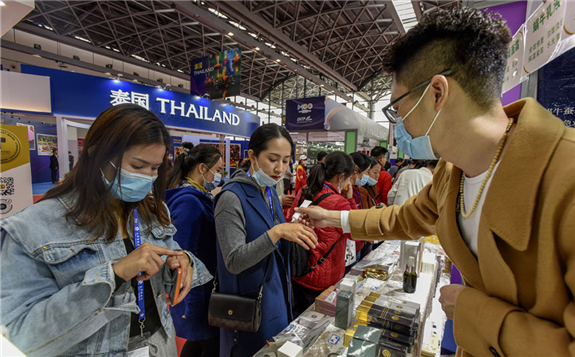
One-third of China's foreign trade goods to be tariff-free after deal implementation
The Regional Comprehensive Economic Partnership agreement is expected to take effect by the end of this year, enabling more than one-third of China's foreign trade goods to enjoy zero tariffs in the next stage, a senior government official said on Monday.
Commerce Minister Wang Wentao said the pact will drive the opening-up of services and investments, promote trade facilitation and improve the business environment in the country.
China will take the opportunity to expand trade and investment activities in the region, stabilize industrial and supply chains and form new advantages in global economic cooperation and competition. Besides, China will highlight the characteristics of local economic development and fully integrate into the huge market, Wang said.
The minister said at a national online training session that the government will systematically introduce articles about the deal on goods, services, investment, rules of origin, Customs facilitation and other areas. Its goal is to assist local governments, industry associations and export-oriented companies to be familiar with RCEP rules.
The mega trade deal was signed by China, Japan, the Republic of Korea, Australia, New Zealand and 10 member states of the Association of Southeast Asian Nations on Nov 15, 2020. The RCEP is also the world's biggest free trade bloc, covering 2.27 billion people, or almost 30 percent of the global population, with a combined gross domestic product of $26 trillion, or about 30 percent of global GDP in 2019, data from the ministry showed.
At present, all the signatories are actively pushing for early clearances for the pact. It will come into force and be implemented after ratification by six ASEAN economies and three non-ASEAN countries, said Wang Shouwen, vice-minister of commerce.
With the signing of the RCEP, China has sealed 19 free trade agreements with other countries and has 26 free trade partners, he said. After the implementation of the RCEP, China's foreign trade volume with its FTA partners will increase from 27 percent to 35 percent, indicating more than one-third of its foreign trade goods will be tariff-free.
Wang urged Chinese companies to take advantage of the cumulative rules of origin, because the benefit of the RCEP lies in the adoption of such rules.
"When products are exported to other RCEP member states, intermediate goods from multiple member states can be added into the value-added standard, which greatly lowers the threshold of the goods benefits," he said. "Therefore, more goods can have access to tariff reductions."
The RCEP will build a solid foundation for China to substantially push forward the China-Japan-ROK free trade process, together with China's announcement of favorably considering joining the Comprehensive and Progressive Agreement for Trans-Pacific Partnership, or CPTPP, said Wang.
Zhao Ping, vice-president of the research institute at the Beijing-based China Council for the Promotion of International Trade, said China must seize this rare opportunity to mitigate the COVID-19 pandemic effect and other uncertainties to the regional economy by actively promoting the implementation of the RCEP, sharing the development dividends of the FTA and relying on the regional market and various connectivity facilities to achieve win-win cooperation.
Promoting regional economic and trade ties on the RCEP platform will open new frontiers for economic growth in China and provide new impetus to regional and even global economic recovery and growth, Zhao said at an economic forum held by China News Service on Monday.